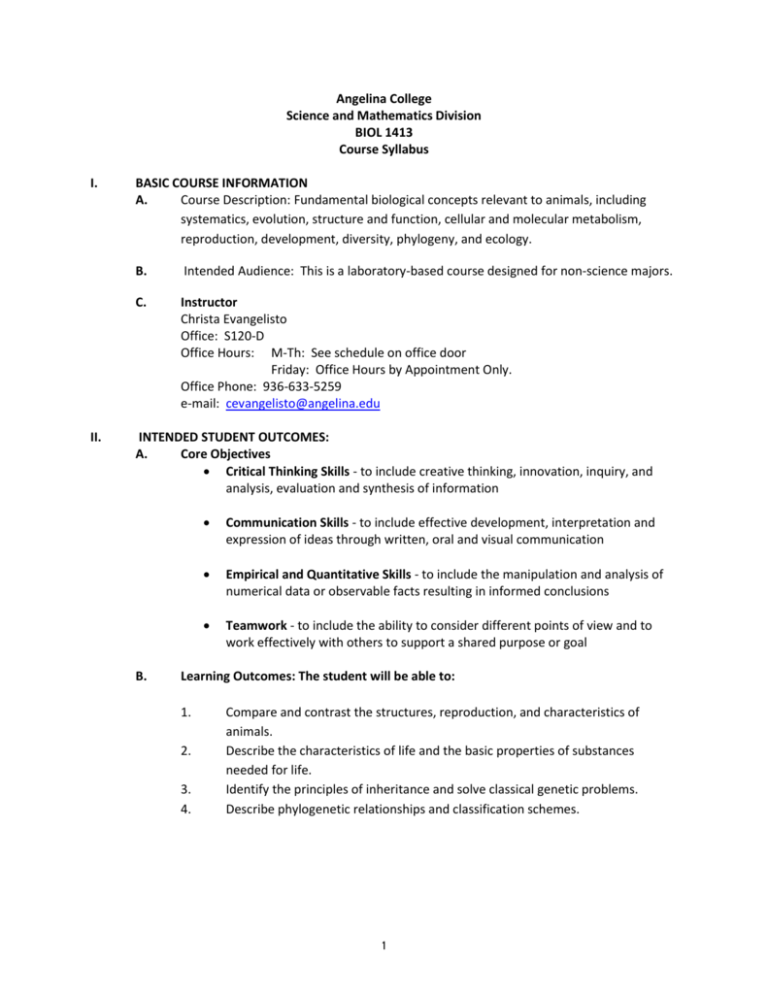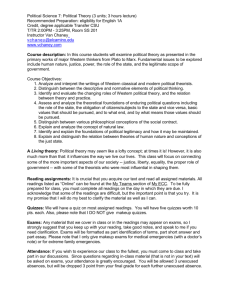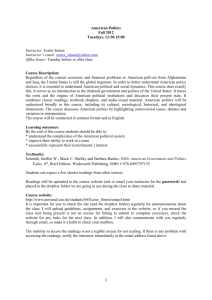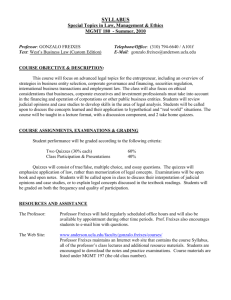Syllabus
advertisement

Angelina College Science and Mathematics Division BIOL 1413 Course Syllabus I. II. BASIC COURSE INFORMATION A. Course Description: Fundamental biological concepts relevant to animals, including systematics, evolution, structure and function, cellular and molecular metabolism, reproduction, development, diversity, phylogeny, and ecology. B. Intended Audience: This is a laboratory-based course designed for non-science majors. C. Instructor Christa Evangelisto Office: S120-D Office Hours: M-Th: See schedule on office door Friday: Office Hours by Appointment Only. Office Phone: 936-633-5259 e-mail: cevangelisto@angelina.edu INTENDED STUDENT OUTCOMES: A. Core Objectives Critical Thinking Skills - to include creative thinking, innovation, inquiry, and analysis, evaluation and synthesis of information B. Communication Skills - to include effective development, interpretation and expression of ideas through written, oral and visual communication Empirical and Quantitative Skills - to include the manipulation and analysis of numerical data or observable facts resulting in informed conclusions Teamwork - to include the ability to consider different points of view and to work effectively with others to support a shared purpose or goal Learning Outcomes: The student will be able to: 1. 2. 3. 4. Compare and contrast the structures, reproduction, and characteristics of animals. Describe the characteristics of life and the basic properties of substances needed for life. Identify the principles of inheritance and solve classical genetic problems. Describe phylogenetic relationships and classification schemes. 1 5. 6. 7. 8. 9. 10. 11. 12. III. Identify the major phyla of life with an emphasis on animals, including the basis for classification, structural and physiological adaptations, evolutionary history, and ecological significance. Identify the chemical structures, synthesis, and regulation of nucleic acids and proteins. Identify the substrates, products, and important chemical pathways in respiration. Describe the unity and diversity of animals and the evidence for evolution through natural selection. Describe the reasoning processes applied to scientific investigations and thinking. Describe basic animal physiology and homeostasis as maintained by organ systems. Describe modern evolutionary synthesis, natural selection, Mendelian inheritance, micro and macroevolution, and speciation. Describe the structure of cell membranes and the movement of molecules across a membrane. ASSESSMENT MEASURES OF STUDENT LEARNING OUTCOMES A. Assessments for Core Objectives 1. Critical thinking – Critical thinking skills will be assessed using embedded test questions focusing on analysis, synthesis and evaluation of biological phenomena. 2. Communication – Communication skills will be assessed using lab reports and embedded test questions focusing on best practices in written, visual, and oral communication. 3. Empirical and Quantitative Skills – Empirical and quantitative skills will be introduced and assessed using embedded test questions focusing on calculations in genetics and population dynamics. 4. Teamwork – Teamwork skills will be assessed using teamwork skill sin lab exercises as well as embedded test questions focusing on best practices. B. Learning Outcomes 1. Students will compare and contrast the structures, reproduction, and characteristics of animals by answering multiple choice questions. 2. Students will describe the characteristics of life and the basic properties of substances needed for life by answering multiple choice questions. 3. Students will identify the principles of inheritance and solve classical genetic problems by answering multiple choice questions. 4. Students will describe phylogenetic relationships and classification schemes by answering multiple choice questions. 5. Students will identify the major phyla of life with an emphasis on animals, including the basis for classification, structural and physiological adaptations, 2 6. 7. 8. 9. 10. 11. 12. evolutionary history, and ecological significance by answering multiple choice questions. Students will identify the chemical structures, synthesis, and regulation of nucleic acids and proteins by answering multiple choice questions. Students will identify the substrates, products, and important chemical pathways in respiration by answering multiple choice questions. Students will describe the unity and diversity of animals and the evidence for evolution through natural selection by answering multiple choice questions. Students will describe the reasoning processes applied to scientific investigations and thinking by answering multiple choice questions. Students will describe basic animal physiology and homeostasis as maintained by organ systems by answering multiple choice questions. Students will describe modern evolutionary synthesis, natural selection, Mendelian inheritance, micro and macroevolution, and speciation by answering multiple choice questions. Students will describe the structure of cell membranes and the movement of molecules across a membrane by answering multiple choice questions. IV. INSTRUCTIONAL PROCEDURES A. Methodologies common to all sections This course will be taught using a combination of lectures and laboratory exercises that complement and supplement lecture material. Audio-visual materials, models, and dissection of specimens will be employed to enhance lecture and laboratory presentations. Online sections will do lecture lessons online, and labs at home with a lab kit. V. COURSE REQUIREMENTS AND POLICIES A. Required Textbooks and Equipment 1. Textbooks a. Zoology by Hickman, et al, (W. C. Brown/McGraw Hill) Sixteenth Edition. b. Exploring Zoology: A Laboratory Guide by Smith & Schenk, (Morton Publishing) 2nd Edition. B. Course Policies – (This course conforms to the policies of Angelina College as stated in the Angelina College Handbook.) Academic Assistance – If you have a disability (as cited in Section 504 of the Rehabilitation Act of 1973 or Title II of the Americans with Disabilities Act of 1990) that may affect your participation in this class, you should see Karen Bowser, Room 208 of the Student Center. At a post –secondary institution, you must self-indentify as a person with a disability; Ms. Bowser will assist you in with the necessary information to do so. Attendance Policy – Attendance will be required as per Angelina College Policy. Records will be turned in to the academic dean at the end of the semester. Do not 3 assume that non-attendance in class will always in an instructor drop. You must officially drop a class or risk receiving a failing grade. This is official Angelina College Policy. The last day to drop the class with a “W” is ____________. Policies Established by the Instructor Online course will have attendance monitored via activity in the course. For face to face courses attendance in both the lecture and laboratory portions of this course is absolutely required and will be taken at the beginning of each class period. A student’s grade will be dropped ONE FULL LETTER GRADE if (1) a student has 3 or more absences in lecture or (2) a student has 3 or more absences in lab. Note: If a student has met both requirements (3 absences in both lecture & lab), their grade will drop 2 full letter grades from their final class average. Additional grade decreases will result if a student has 4 or more absences in either the lecture or laboratory portions of the class. Arriving and departing class on time is essential to the effective flow of classroom dynamics. As a result, late arriving and early exiting of the classroom will result in onehalf of an absence (i.e. two late arrivals = 1 full absence), unless otherwise pre-approved by the instructor. Course Conduct 1. Absolutely no cell phone use is allowed during labs or class. 2. No Food, drinks, or tobacco in class. 3. Courteous and respectful behavior will be expected in class at all times. VI. COURSE SCHEDULE Week 1 Jan 19 Topic(s) Introduction to Zoology Taxonomy Chemistry of Life 2 Jan 26 Cells/ Mitosis Cellular Metabolism 3 Feb 2 Exam 1 Genetics 4 Feb 9 Genetics Evolution 5 Feb 16 Reproduction Architectural Patterns Readings, Activities, & Assessments Readings: Ch 1 p. 1-12 Ch 10 p. 196-212 Ch 2 p.19-26 Assignment: Chapter Quiz Ch 1 & 2 Readings: Ch 3 p. 35-44, 50-53 Ch 4 p. 55-69 Assignment: Chapter Quiz Ch 3 & 4 Exam1 on Feb 2 (Chapters 1-4, 10) Readings: Ch 5 Readings: Ch 5 Ch 1 p. 13-14 Ch 6 p.99-111, 120-122 Assignment: Chapter Quiz Ch 5 & 6 Readings: Ch 7 Ch 8 p. 168-173 Ch 9 Assignment: Chapter Quiz Ch 7 & 9 4 6 Feb 23 7 Mar 2 Exam2 on Feb 23 (Chapters 5-9) Readings: Ch 11 Assignment: Chapter Quiz Ch 11 & 12 Readings: Ch 12, Ch 13 Sponges, Placozoans; Ch 14 p. 290-306 Radiate Animals Ch 16 Flatworms, Mesozoans, Ribbon Worms; Molluscs Assignment: Chapter Quiz Ch 13 & 16 9 Mar 16 10 Mar 23 Annelids and Allies 11 Mar 30 Arthropoda Echinodermata Exam 3 Nematoda Arthropoda 12 Apr 6 Exam 4 Chordates 13 Apr 13 14 Apr 20 Fishes Amphibians Reptiles Birds Mammals Exam5 15 Apr 27 May 4 May 7-13 VI. Exam 2 Protozoans Review Finals Readings: Ch 17 p. 360-378 Assignment: Chapter Quiz Ch 17 Exam3 on Mar 23 (Chapters 11-17) Readings: Ch 18 p. 382-390 Ch 19, 20, 21 Assignment: Chapter Quiz Ch 18 & 19 Readings: Ch 22 p. 465-466, 468-485 Assignment: Chapter Quiz Ch 20 & 22 Exam4 on Apr 6 (Chapters 18-22) Readings: Ch 23 Assignment: Chapter Quiz Ch 23 Readings: Ch 24, Ch 25 Assignment: Chapter Quiz Ch 24 & 25 Readings: Ch 26, Ch 27, Ch 28 Assignment: Chapter Quiz Ch 26 & 27 Exam5 on Apr 27 (Chapters 23-28) Final Exam EVALUATION AND GRADING A. Grading Criteria (percents, extra credit, etc.) Lecture and lab grades will be combined to give one grade for the course. Lab is worth 1/3 of the total course grade. Lecture (2/3 of total course grade) Regular Exams (5 total) 500 points Comprehensive Final Exam 100 points Homework/Quizzes 50 points 5 B. Lecture Exams: Testing Procedures: If you are in an online course, SEE THE TESTING PROCEDURES OUTLINED BY THE INSTRUCTOR. For face to face courses: At the college level, academic honesty is of most importance. As a result, ALL PERSONAL BELONGINGS (including cell phones, backpacks, hats, etc…) will be placed at the front of the classroom before each test. A student may only take writing utensils, scantrons, a copy of the test, and a calculator (if necessary) to their desks on test days. * STUDENTS ARE REQUIRED TO PROVIDE THEIR OWN SCANTRONS (FORM 882-E) FOR EACH EXAM! There will be five regular lecture exams that will be given as shown on the class schedule. The final exam is comprehensive. The grade on the comprehensive portion of the final exam can replace the single lowest grade on the regular exams. No make-up exams will be given for any reason. If you miss an exam, the final exam grade will replace the grade of that missed exam. Extra credit may be offered at the instructor’s discretion; however, extra credit for lecture will be worth a maximum of 10 points. The instructor may modify the provisions of the syllabus to meet individual class needs by informing the class in advance as to the changes being made. 6






